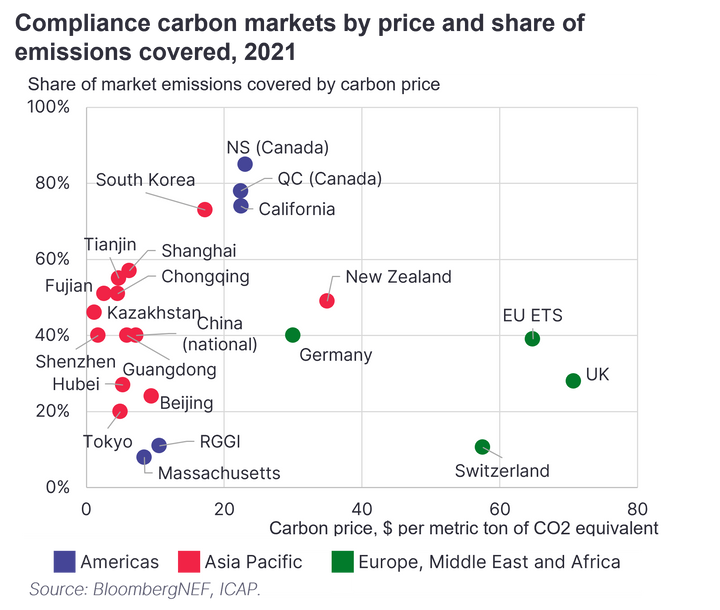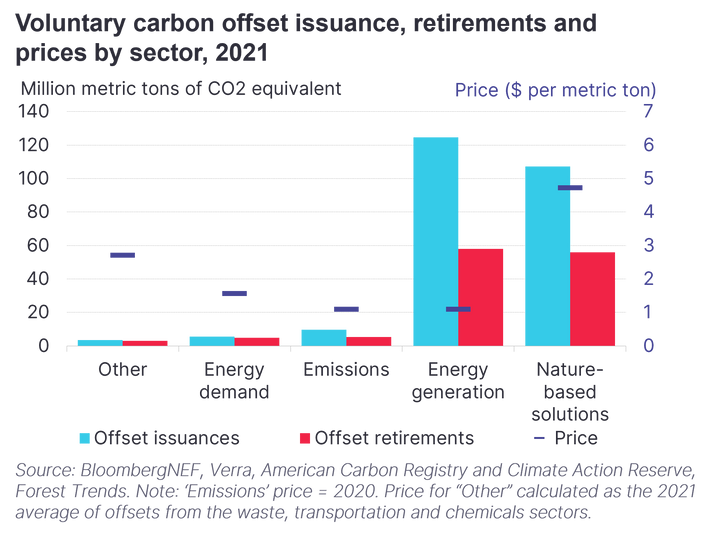Global carbon markets have grown exponentially in the last few years. Governments’ increasingly ambitious climate targets have led to new compliance emission-trading schemes and higher prices in existing carbon markets. The voluntary markets have also seen a surge in demand on the back of bold corporate sustainability pledges. But supply has failed to keep up, leaving the markets overflowing with cheap, low-quality offsets because of poor oversight.
Key message
Governments have implemented over 30 compliance carbon markets around the world but few have prices high enough to drive decarbonization. Meanwhile, companies’ increasingly ambitious climate targets mean demand for carbon offsets has never been higher. But the voluntary carbon markets remain oversupplied.
#Compliance markets
A growing number of countries with decarbonization ambitions have introduced compliance carbon markets as a more politically palatable option than carbon taxes. More than 30 such programs are in force, covering more than a fifth of global greenhouse-gas emissions. In particular, the volume of emissions covered rose 42% in 2021, mainly due to the launch of China’s national carbon market. The EU Emissions Trading System (EU ETS) now ranks second in size.
In addition, these compliance markets are growing rapidly in terms of traded value – a result of the rising price per unit of emissions traded. The total value of global compliance markets climbed 160% in 2021, up to $851 billion according to Refinitiv. More than 90% of this increase was driven by the EU ETS, which saw prices reach $95 per metric ton of CO2 equivalent by end-2021 – up from $40 per ton at the beginning of the year. Other markets also had price increases in 2021, including the New Zealand Emission Trading Scheme and California’s Cap-and-Trade Program. Allowance prices in compliance carbon markets averaged around $21 per metric ton in 2021.

However, less than 4% of global emissions are covered by an explicit carbon price in or above the estimated range required to limit global warming to 2 degrees C above pre-industrial levels by the end of the century. This range was estimated to be $40-80 per ton by 2020 and $50-100 by 2030, according to the World Bank’s High-Level Commission on Carbon Prices 2017 report.
Compliance carbon markets tend to focus on certain sectors, with power generation and industry being the most common. These typically comprise a limited number of emission-intensive companies, thereby reducing the administrative burden for regulators. However, as the power sector is decarbonized through renewables, governments are increasingly looking to expand compliance carbon markets to other sectors – such as transport, buildings, or agriculture – which have many point sources but make up an increasing share of emissions.
Moreover, seven major compliance carbon markets around the world now allow the use of offsets in some form, such as stipulations for locally generated carbon offsets, and a limit for the proportion of offsets allowed to be used toward compliance obligations. Compliance markets such as the EU ETS and New Zealand used to permit companies to use offsets generated under the Kyoto Protocol’s Clean Development Mechanism (CDM) and Joint Implementation for compliance, but stopped doing so after the vast availability of offsets contributed to an oversupply in the market, causing prices to crash.
#Voluntary markets
Alongside governments’ climate goals, corporate net-zero targets have created soaring demand for offsets in voluntary carbon markets, and companies counted a record volume of offsets toward their goals for the fifth consecutive year in 2021. But supply still outstrips demand, after low-carbon projects issued an even larger quantity of offsets.
Despite the hype, voluntary markets remain small, with a traded value of $1-2 billion in 2021 compared with $851 billion for compliance markets. The price of voluntary carbon offsets varies by country and sector, averaging just under $4 per ton in 2021. The main drivers are the sector of the project and its additionality – whether decarbonization would not have happened without offset revenue. Offsets from energy generation projects are the cheapest as they typically have low additionality. For example, renewable build in most of the world (except least-developed countries) is economically feasible without additional support. Offsets from projects that protect, manage sustainably or restore natural ecosystems are among the most expensive as they rank highly on the additionality spectrum. A project’s location and age, or vintage, also impact offset prices.
The most common offset sectors include nature-based solutions (including avoided deforestation and reforestation), energy generation and projects that capture fugitive emissions. Energy generation made up 43% of offsets retired on Verra, the largest registry in 2021. But this share of the market is set to shrink in the coming years, following the registry’s decision in 2020 to exclude registering new energy generation projects in developed countries on account of their low additionality.

Although 98% of offsets retired in 2021 were created in Asia Pacific, Latin America and Africa, 84% of these were bought by companies in North America and Europe. Yet this trend may be short-lived, after emerging markets have begun to ban or restrict exports of offsets over fears they will not have enough remaining credits to meet their own goals. Indonesia, India and Papua New Guinea, which have taken such steps, accounted for over a quarter of global offset supply in 2021.
Article 6 of the Paris Agreement established various tools to enable countries and companies to achieve their climate goals via collaboration on global carbon trading – namely Article 6.2, which allows parties to cooperate using internationally transferred mitigation outcomes (ITMOs), and Article 6.4, which established a global offset market similar to the Clean Development Mechanism. While Article 6 could help scale up and standardize offset markets, its exact implementation is still being determined and could take months or years.
Stay up to date
Sign up to be alerted when the web platform goes live.